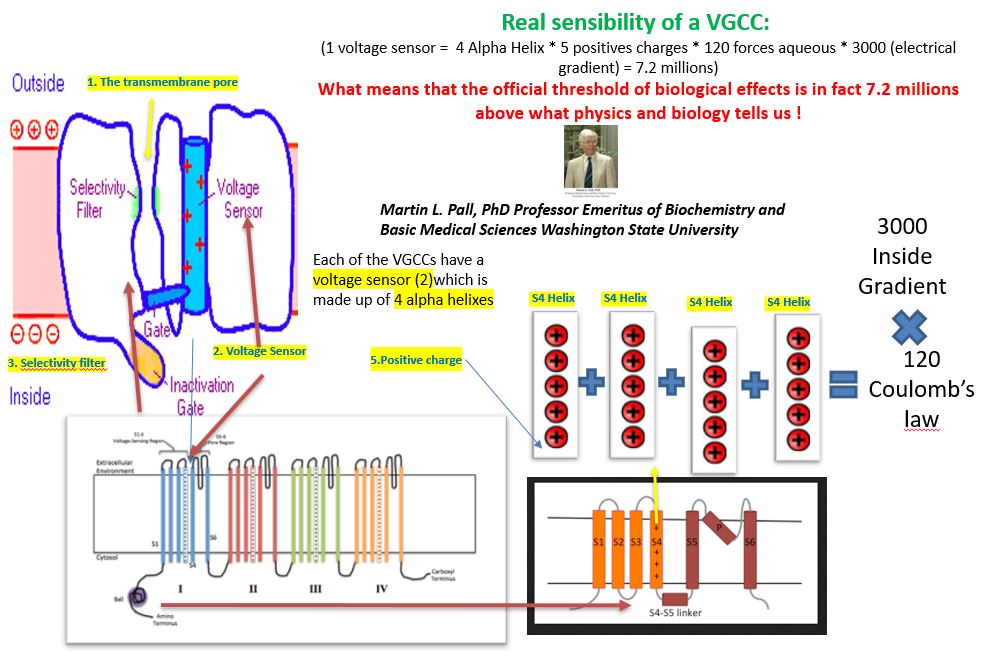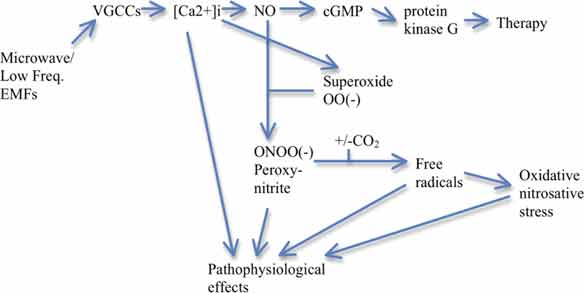Pr Martin Pall from Washington University explains that in fact, and in total contradiction with the standards and guidelines of safety found with every manufacturer of NTIC, that a signal of an intensity several millions less than the ” S.A.R” ( stands for specific absorption rate.. what is more or less a big balloon of water to mimic a human brain…(when we know a head is an open circuit, not a static mass), such a small signal is sufficient to modify the action potential in a cell, leading to unwanted openings of ion channels. This is why we call the VGIC the “weak link of the chain” because it is one of the multiple ways the smallest articificial, polarized electromagnetic field can affect our homeostasis, the way our body manage ions in our body.

Explanation of the hypersensitivity of the sensors in Voltage Gated Ion Channels:
Pr Martin Pall (Pr Emeritus Washington State University) is known to be the author of the discovery of the mechanisms involved in Electro hypersensitivity, pointing out the extreme sensitivity of the voltage sensors to the smallest electromagnetic field:
“Because the plasma membrane has a high electrical resistance whereas the aqueous parts of the cell are highly conductive, the electrical gradient across the plasma membrane is estimated to be concentrated about 3000-fold. The combination of these factors means that comparing the forces on the voltage sensor with the forces on singly charged groups in the aqueous parts of the cell, the forces on the voltage sensor are approximately 20 X 120 X 3000 = 7.2 million times higher. The physics predicts, therefore, extraordinarily strong forces activating the VGCCs via the voltage sensor. It follows that the biology tells us that the VGCCs are the main target of the EMFs and the physics tells us why they are the main target. Thus, the physics and biology are pointing in the same direction.”
Source below:
Electromagnetic Fields Act Similarly in Plants as in Animals: Probable Activation of Calcium Channels via Their Voltage Sensor
Author(s): Martin L. Pall.

Abstract:
It has been shown that low intensity microwave/lower frequency electromagnetic fields (EMFs) act in animals via activation of voltage-gated calcium channels (VGCCs) in the plasma membrane, producing excessive intracellular calcium [Ca2+]i, with excessive [Ca2+]i leading to both pathophysiological and also in some cases therapeutic effects.
The pathophysiological effects are produced largely through excessive [Ca2+]i signaling including excessive nitric oxide (NO), superoxide, peroxynitrite, free radical formation and consequent oxidative stress.
The activation of the VGCCs is thought to be produced via EMF impact on the VGCC voltage sensor, with the physical properties of that voltage sensor predicting that it is extraordinarily sensitive to these EMFs.
It is shown here that the action of EMFs in terrestrial, multicellular (embryophyte) plants is probably similar to the action in animals in most but not all respects, with calcium channel activation in the plasma membrane leading to excessive [Ca2+]i, leading in turn to most if not all of the biological effects.
A number of studies in plants are briefly reviewed which are consistent with and supportive of such a mechanism.
Plant channels most plausibly to be involved, are the so-called two pore channels (TPCs), which have a voltage sensor similar to those found in the animal VGCCs.
